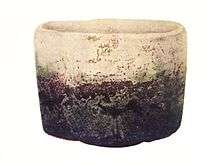Arita ware
_with_Domestic_Scenes_-_Walters_49475_-_Three_Quarter_View_B.jpg)

Arita ware (有田焼 Arita-yaki) is a broad term for Japanese porcelain made in the area around the town of Arita, in the former Hizen Province, northwestern Kyūshū.
History
According to tradition, the Korean potter Yi Sam-pyeong (d. 1655), or Kanagae Sanbee (金ヶ江三兵衛), is often considered the father of Arita ware porcelain.[1][2] This narrative is however disputed by many historians.[3][4] He is nevertheless honoured in Sueyama Shrine as the founder.
The first porcelain made in Japan followed the discovery of porcelain clay near Arita near the end of the 16th century. A number of kilns opened up in the area, and a considerable variety of styles were made, the Japanese export porcelain destined for Europe generally using Western shapes and Chinese decoration.[5][2] Early wares used underglaze blue decoration, but by the mid-17th century Arita was in the forefront as Japan developed overglaze "enamelled" decoration in a range of bright colours.[6]
Between the second half of the 17th century and the first half of the 18th century they were extensively exported to Europe, travelling initially from Arita's port of Imari, Saga to the Dutch East India Company's outpost at Nagasaki. The type called kin-rande was especially popular and is therefore known in the West also as Imari ware (伊万里焼 Imari-yaki).
Nabeshima ware developed out of Arita, which was of a higher quality produced for the Nabeshima Lords of the Saga Domain.
Kakiemon is a style of porcelain that developed out of Arita.
The kilns in Arita also produced white Hakuji porcelain.[6]
References
- ↑ "Arita, Imari and Karatsu. Explore the villages of ceramics. | JAPAN Monthly Web Magazine". Japan-magazine.jnto.go.jp. Retrieved 2016-09-13.
- 1 2 Larking, Matthew (2016-05-21). "Arita ware: Traditional Japanese porcelain has an international history". The Japan Times. Retrieved 2016-09-13.
- ↑ Komiya Kiyora 小宮木代良, "tōso" gensetsu no rekishiteki zentei 「陶祖」言説の歴史的前提, Nitchō kōryū to sōkoku no rekisi 日朝交流と相克の歴史, pp. 363-381, 2009.
- ↑ Komiya Kiyora 小宮木代良, "tōso" gensetsu no seiritsu to tenkai 「陶祖」言説の成立と展開 (The origins and expansion of the story of Touso, the first ceramist), Kyūshū Shigaku 九州史学, No. 153, pp. 49-74, 2009.
- ↑ "Japan Pottery Net / Ceramics's profile | Arita Ware". Japanpotterynet.com. Retrieved 2016-09-13.
- 1 2 Smith, Harris, & Clark, 163-165; Ford & Impey, 61-118; Watson, 260-261
Further readings
- Ford, Barbara Brennan, and Oliver R. Impey, Japanese Art from the Gerry Collection in The Metropolitan Museum of Art, 1989, Metropolitan Museum of Art, fully online
- Smith, Lawrence, Harris, Victor and Clark, Timothy, Japanese Art: Masterpieces in the British Museum, 1990, British Museum Publications, ISBN 0714114464
- Watson, William ed., The Great Japan Exhibition: Art of the Edo Period 1600–1868, 1981, Royal Academy of Arts/Wiedenfield and Nicolson
External links
![]() Media related to Arita ware at Wikimedia Commons
Media related to Arita ware at Wikimedia Commons
